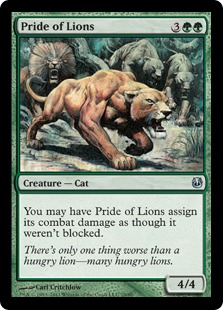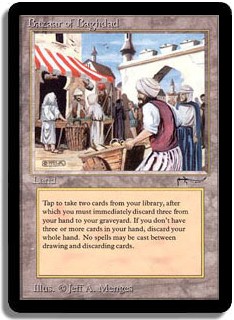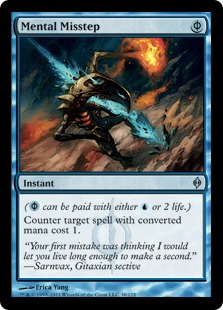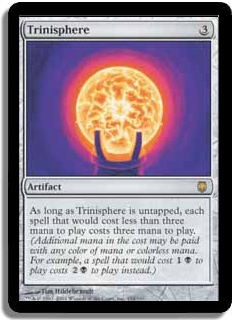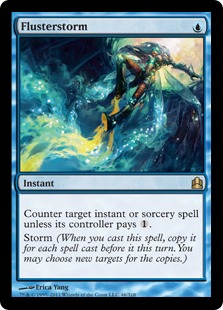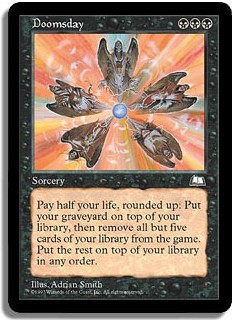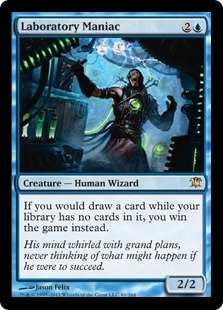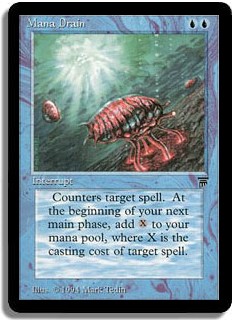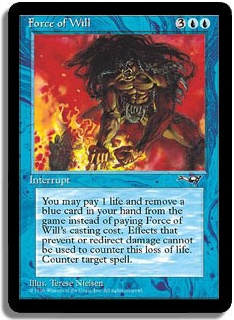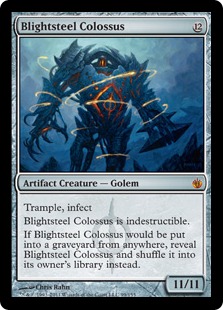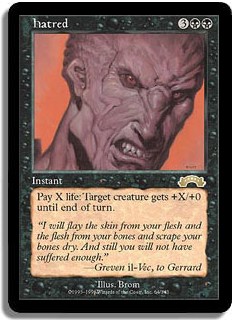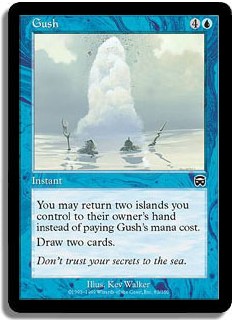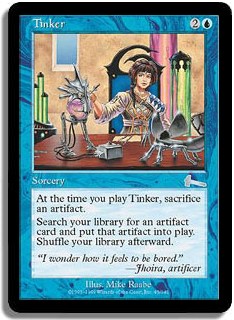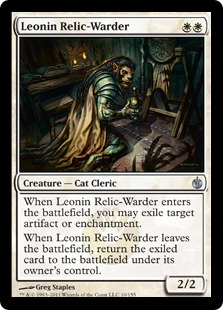HOW VINTAGE IS A LOT LIKE THE DETROIT FOOTBALL LIONS:
Vintage, as a format, has many strikes against it, which is unfortunate because Magic’s oldest format is a fun and interesting environment well worth exploring. If it wasn’t unappealing enough that many of the cards individually cost hundreds of dollars each, Vintage has also always suffered from the misconception that every game is a turn-one kill, of sorts. Whenever a non-Vintage player asks me: “You play Vintage? Isn’t that the format where everybody wins on the first turn?” I’d always chuckle to myself and explain that while it is possible to assemble a turn-one win, that these situations are much more the exception than the rule and that most Vintage games are capable of being contested by both sides and are ultimately decided by the superior strategist through tight play; and, to the best of my knowledge and expert understanding of Vintage, my view of Vintage as a fair, balanced, and highly skilled format was true.
Last weekend I attended the TMD Open, also known as Waterbury, a Vintage tournament in Stratford, Connecticut, where much of the ideology about Vintage I had long believed to be true was quickly dispelled. The one thing that has always remained constant about Vintage is that the community is awesome, and in keeping with that tradition, I can attest that hanging out with the Vintage guys was a blast. Vintage fans are particularly diehard, super loyal to the format they love, and a lot of fun to game with. In a lot of ways, Vintage fans remind me of my hometown Detroit Lions fans, where for years and years nobody on the outside cared about the Lions; in fact most openly mocked the team for being terrible, yet Lions fans still loyally showed up to watch.
The mocking question “Did they take away your nationally televised Thanksgiving Day game yet?” is in a lot of ways similar to “Isn’t Vintage dead yet?”
As a loyal Lions fan during the lean years, I felt the diehard Detroit fans deserved a better product than was being put on the field, and similarly as a diehard Vintage fan I also believe that the people who play Magic’s oldest format also deserve a better product than what is currently being offered: Vintage is too fast.
AND, I’VE GOT YOU IN CHECKMATE IN TWO MOVES (ALSO, DID YOU WANT TO BE THE WHITE OR BLACK PIECES?)
The most egregiously common Vintage endgames are as follows:
It is turn two: I have two lands, a Mox, and a Blightsteel Colossus in play.
It is turn two: I have Fastbond and am casting Gush.
It is turn two: I have Bazaar of Baghdad.
The problem with these common openings/endgames is that they require a disproportionately low number of resources to assemble compared to the return a player gets on their investment. It would be the chess equivalent to an opening where: I move up a pawn; my opponent blocks my pawn; I then move out my knight, and my opponent is magically in checkmate. If such a ridiculous opening existed in chess, one would assume that there was a design flaw in the structure/strategy of the game…
The number one reason I believe that Vintage is too fast is that the format has reached a critical mass of “free” spells. Between the Moxes, Lotus, Mana Crypt, Gush, Force of Will, Mental Misstep, and the Dredge deck—only a sucker would bother to pay mana for their spells in an environment where it isn’t necessary.
Mental Misstep is a really interesting card in Vintage right now. On the one hand, it does almost nothing against Mishra’s Workshop decks or Dredge decks, but against other blue decks or decks that curve out on spells, Misstep—just like in Legacy—is absurdly good. Being able to generate tempo by trading a card for the opponent’s card, which they spent mana on, is a very strong play in Eternal formats. On the critical turn of the game, it usually ends up simply being a Force of Will, since it can counter all sorts of spicy spells ranging from Duress to Ancestral Recall, from Red Blast to Spell Pierce.
Mental Misstep also makes it very easy to proactively assemble double counter protection for one’s own threats in the first two turns. For instance, I had a game against Chris Pikula where I was on the play and led with Volcanic Island. On his turn he played his raw-dog Ancestral Recall, and I Red Elemental Blasted his Ancestral. He Mental Misstepped my Red Blast, and I Force of Willed his Misstep, and he Forced back.
We now live in a world where double counter for a turn-one threat is fairly commonplace, thanks to the fact that there is a new sheriff in town, Mental Misstep.
I had a lengthy debate on our team boards with Steven Menendian where he argued that more free spells don’t necessarily speed up the format, especially in the case of free permission like Mental Misstep, because cards like Gush and Misstep don’t necessarily change the average turn upon which games of Vintage end. In order for me to say that Vintage was “too fast,” it would have to mean that it took significantly fewer turns to play games in Vintage, from then to now.
Just to be clear, I don’t have that specific data handy nor do I aspire to compile that kind of a survey (I surveyed for the TOP 100 CARDS IN VINTAGE, and I’d literally rather draft Lorwyn than do that again!); however if the primary indicator of ‘speed’ or ‘fastness’ one needs is an average of turns, then that person will be sorely disappointed.
Let the record show that it is my opinion that if such data could somehow be acquired that the average number of turns in the current era with Blightsteel Colossus / Gush / Dredge would likely be the fastest dating back to the last Gush era. Steven, on the other hand, speculates that it would be relatively the same. In my opinion, just the printing of Blightteel alone should change the data, at least slightly, since every time Tinker went the distance, it now likely took one turn as opposed to two, and, well, it’s Vintage, and people Tinker a lot.
THE MYTH OF TURNS
The other problem that I have with judging the speed of a format with how many turns a game lasts is that such a determiner presumes that all of the turns were meaningful or equally productive for both players. For instance, what if I cast turn one Trinisphere,
and win on turn ten? Assume my opponent never actually cast a spell, but took five turns. Did he really take five turns? Would my deck be faster if I had Tendrils of Agony’d him to death on one? It is really difficult to sort out these kinds of problems. Is Lodestone Golem + Chalice of the Void backed up by running Sphere of Resistance and a Strip Mine really the equivalent of a turn-four kill?
The Vintage deck that is most likely to goldfish a turn-one victory in Vintage is 2-Land Belcher, but nobody plays that deck. If it is the fastest deck in the format; why is it one of the least popular deck selections for a tournament?
The reason is that the fastest deck in the format isn’t necessarily the best deck in the format because players don’t win tournaments for winning the fastest. They win events for winning the most. While being able to win quickly is considered a boon, it isn’t the only variable at play in a game of Magic. In order to win a game of Magic—and this is paramount—not only does a player need to assemble a combination of cards that achieve conditions for victory, but that player’s opponent has to have nothing left they can do to stop it.
WHAT HAPPENS WHEN EVERYBODY PLAYS DURESS?
The card Duress, which is played in many fast combo decks, doesn’t actually make the goldfish clock any faster. In fact, if a player is merely trying to goldfish their deck, drawing Duress will likely make you goldfish slower. However, in an actual game of Magic under tournament conditions, Duress actually does make a deck win the game more quickly. The reason is that Duress takes away one of the opponent’s strategic options that would have stood in the way of a player’s ability to assemble conditions under which victory is possible.
Duress is an example of a card that while making one’s deck “slower” actually makes the deck faster!
When I’m talking about the format being faster, it is paramount to take this specific type of interaction under consideration because let’s face it, most of the cards that allow for turn-one, two, or three wins in Vintage have been with us for a long, long time. Many turn-one victories result from drawing cards that date back to the very genesis of the game: Ancestral Recall, Time Walk, Black Lotus, and Fastbond. The problem isn’t that the average turn of victory is any faster—because it has always been possible to goldfish very quickly in Vintage—the problem is that the window in which opponents can interact with fast combo draws is perhaps slimmer and more pressured than ever before.
The in-game example I provided from my game with Pikula is a good example of this phenomenon, where on turn one he was able to double counter me while I was trying to stop a turn-one Ancestral Recall. He didn’t win the game on turn one—or did he? I wasn’t technically dead, but let’s investigate what actually happened. After his Ancestral Recall resolved, I had four cards left in my hand (including the one I drew for my draw step, which was ironically Mental Misstep, which he can confirm because I revealed it to him as I jokingly shook my hand in jesting disgust…), whereas he now had seven cards, not to mention my advantage from being on the play was also undone because my Volcanic Island was now tapped, and he was going to take the play to me when he got to untap his land on his turn.
Sure according to Smennen’s assessment this isn’t the same as a turn-one victory, but it might as well have been, since I am now so far behind in resources as well as position that short of him having absolutely nothing there are very few ways I’ll be able to battle back into this game. In my estimation, free counters are not a wash and have no impact on the speed of the format but actually speed up the amount of time and limit the amount of ways a player can interact and utilize the meaningful or contested space within the game for advantage.
If we want to talk about the collapse of the time and space for interaction in the early turns of games of Vintage in relation to other previous eras, I can tell you with certainty that the amount of times and the ease with which players can assemble double counter protection for their proactive turn one or two moves in a game is much, much, much more common than it ever has been before.
Here is the card that I wish had been in my hand when Pikula ran out his turn one Ancestral Recall in our Vintage 3v3 match:
Here is a card that I wish I had in my hand instead of Red Blast!
The presence of Flusterstorm, which should help control the problem of fast decks, actually only serves to compound the problem by providing a near unstoppable one-mana proactive solution to permission. I saw far more Gush combo decks playing Flusterstorm than fair decks using it to fight back, and unsurprisingly the combo decks packing Flusterstorm were doing much better than the fair decks that chose to play this card.
The worst offender, a deck that I am pretty sure we haven’t seen the last of, is the Doomsday/Gush/Laboratory Maniac deck.
While Flusterstorm in theory should be great against a Gush deck, it actually falls into the same category as Duress, where while Flusterstorm is obviously great against disrupting a degenerate combo deck, it is also equally if not more efficient at being utilized by the combo deck to protect against a stop from the opponent.
So, what happens when everybody plays Duress? The fact that the actual turn on which the game ends doesn’t necessarily mean that the format isn’t “too fast,” it merely means that the format has become so warped around hyper-aggressive one- and two-card combo decks that the meaningful possibilities for interaction become severely limited as each side continues to bolster the ways that they can undo the other’s options more and more quickly.
VINTAGE, AS A FORMAT OF ONE- AND TWO-CARD COMBO DECKS
The Meandeck Doomsday deck is, in my opinion, the crystallization and epitome of everything that is wrong and unbalanced about the modern Vintage era.
The amazing thing about this deck is the synergy between Doomsday and Laboratory Maniac. The card Doomsday literally tutors for Laboratory Maniac, as well as creates the victory condition required for Laboratory Maniac to win the game by virtue of exiling one’s library. With a Gush in hand and two lands in play, a player can simply cast Doomsday and stack their new five-card library as follows: Ancestral Recall, Black Lotus, Lotus Petal, Yawgmoth’s Will, Laboratory Maniac. The player returns two lands to Gush, drawing and playing Lotus and Ancestral, and then the Ancestral draws Lotus Petal, Yawgmoth’s Will, and Maniac. There are a multitude of other utility piles depending upon the circumstances, but the Doomsday deck is yet another example of a fast and consistent Vintage combo deck.
The biggest joke is that as far as the types of cards that are good with interacting with fast combo decks—the “duress” type spells I discuss in the aforementioned section—the Doomsday deck plays more Flusterstorms, Mental Missteps, Duresses, and Thoughtseizes than anybody else—essentially, it quickly takes away its opponent’s ability to interact and then executes its one-card combo to end the game.
The Doomsday deck, like all degenerate Vintage strategies, is kind of cool and interesting the first time you see it—but it isn’t particularly fun or interesting for the format in the long run. Yes, Doomsday is pretty cool when you have to come up with a weird pile to win through some weird hate or fight out of a jam, but more often than not it’s just Key/Vault all wrapped up into a BBB sorcery.
The most disconcerting thing about the current Vintage environment is that the whole format breaks down to one-card and two-card combos. Bazaar of Baghdad = Win. Doomsday = Win. Gush + Fastbond = Win. Voltaic Key = Win. Tinker = Win. The format has devolved away from jostling for position, gaining an advantage, and grinding out a victory into having a card and making the opponent die because said card wins the game if it resolves.
Oh, and by the way, if the primary Doomsday plan doesn’t work out, the pilot always has the mediocre backup Gush + Fastbond plan to fall back on…
Dredge is another example of a one-card combo deck that is proving to be problematic for the format to actually handle. Essentially, the deck only ever needs to assemble the combo of “do I have the card Bazaar of Baghdad in my hand?” in order to execute all of the rest of its conditions for achieving victory. The key difference between Gush and Bazaar of Baghdad decks, in my opinion, is that I still maintain that Dredge is actually beatable, should a player preparedly choose to warp the construction of their deck around wanting to beat it.
However, with Dredge winning the last two major North American Vintage events, perhaps the presence of Dredge as it currently exists isn’t actually an encouraging attribute about the format. If I were to play Vintage tomorrow, the deck I would choose would certainly play two copies of Nihil Spellbomb in the maindeck, and I would likely sideboard 4 Leyline of the Void, 1 Nihil Spellbomb, 1 Tormod’s Crypt, and 1 Surgical Extraction. I believe with this seemingly excessive (yet necessary) amount of Dredge-specific answers, I would pretty easily be able to defeat Dredge in both of my post sideboard games.
Now, imagine that Vintage was a professionally played format and that Dredge had essentially won the last two Pro Tours in a row and that people were using nine of their seventy-five card slots in their deck in order to swing the Dredge matchup in their favor? Would we describe that situation as healthy? Especially when we consider that all Dredge actually needs to do in order to beat the overwhelming majority of non-mirror matchups in game one is simply play a land that almost always allows that deck to disrupt and establish conditions for victory on the second or third turn of the game.
ARE WE SPEEDING OFF TRACK OR DID WE ALREADY CRASH AND ARE ALREADY DEAD?
Looking back, I believe the beginning of the end, or at least the moment where Vintage began to “speed up,” was in Zendikar. It is kind of funny to say so, but here is the card that I believe changed the game:
It’s kind of innocuous now, considering most people don’t even play with this card anymore, but at the time Spell Pierce ushered in the era of one-mana blue permission spells in Vintage. Before Spell Pierce, people generally played Mana Drain and Force of Will in their blue decks, and those were the best tools that we had at the time.
Mana Drain’s hefty color commitment of UU ensured that players generally needed to make two land drops in order to cast the spell. Force of Will, is well, Force of Will, and we deal with that—but people generally had time to DO something before Drain came online, and protecting one’s own threats with Mana Drain generally required a decent amount of setup time (since one would need to have mana to cast their threat plus UU up to protect). Spell Piece, costing just one mana and requiring the opponent to pay more mana than the Pierce itself cost, upped the speed of the game considerably. From the first turn on, instead of the second turn on, a player could be ready to interact on the stack, and generally speaking it sped up the amount of time needed to counter proactively to push through threats by a full turn. Sure, Red Elemental Blast and Pyroblast have always existed, but they never offered the kind of flexibility and versatility that Spell Pierce brought to the table.
Now we live in a world where Spell Pierce is probably too slow and not good enough. Pierce was never particularly great against Workshops, Fish, or Dredge any way and was more a concession to blue being the best. In a world where everybody plays Mental Misstep and Flusterstorm, the guy slinging Spell Pierce is completely outclassed and likely to get blown out.
It is funny that Spell Pierce. while game changing two years ago. has now been made almost obsolete by better, more powerful options.
IF WE ARE DEAD, IS THIS HELL, AND IF SO IS BLIGHTSTEEL COLOSSUS THE DEVIL?
The most miserable printing ever and clear proof that R&D hates Vintage is Blightsteel Colossus.
I actually hate that this card exists more than Bitterblossom, Golgari Grave-Troll, and Mental Misstep combined.
This stupid card, while virtually unplayable in any way shape or form anywhere else in Magic, is unfortunately format-defining in Vintage. Tinker + this card in my deck essentially offer up the gambit of: “Can you deal with my stupid card? Because if not, you lose the game.” Seems fair that casting a 2U sorcery puts my opponent into a situation where if they can’t somehow stop an 11/11 trample, indestructible, infect creature, I somehow deserve to “just win” the game on the spot.
Also, the fact that Tinker for a robot is now a one-turn clock as opposed to at least a three-turn clock also justifies my claim that Vintage is faster than ever before, since every game where Tinker and attack was likely to succeed in the past is now likely to have been successful a full turn more quickly.
For me the most disappointing aspect of the modern Vintage era is the lack of complex strategy, as it is almost always more profitable to “just win” than to try and get lured into a game of Magic. It isn’t to say that there is “no strategy” in Vintage, as there clearly is, but my point is the types of strategy become much more condensed when resolving one-card combos is often enough to win the game, and the efficient “answer” cards—such as Flusterstorm, Spell Pierce, and Red Elemental Blast—are better suited for facilitating and forcing through fast combo kills than they are protecting against or stopping fast combo decks.
It is possible that, moving forward, Vintage will continue to become faster and faster and that with the printing of new enablers (Flusterstorm, Laboratory Maniac, and Past in Flames), even faster, more efficient combo decks will continue to be the way of the future.
“MODERN” VINTAGE?
The DCI’s recent banned and restricted announcement, with regard to the Modern format, seems to suggest that, at least in that format, fast, efficient, and degenerate combo decks are viewed to be unacceptable and detrimental to quality games of Magic being played in a competitive setting. The pruning of the B&R list seems to suggest that resource building and interactive game play are seen to be ideal characteristics of a healthy and complex format.
Generally speaking, I believe that the DCI has done a really good job in developing Modern as a fun, interesting, and playable format and strongly agree with their decisions to ban fast combo enablers.
While I believe that combo decks serve a purpose and provide necessary complexity to the fabric of a healthy and dynamic Magic metagame, the dominance of fast combo severely limits many possible deck choices and inhibits many possibilities that could be possible given the vast card pool in Eternal formats. To say it plainly, it is my opinion that the management of both the Vintage and Legacy B&R lists over the past two years has been at best ignorant and negligent, and at worst an imposition upon individuals who actually value the experience of playing fun and interactive games of Magic. I am going to stay on topic and not diverge into the topic of the many things I don’t like about Legacy, but contextually speaking many of the issues I take with Legacy are similar to the problems that I have grown to have with Vintage.
I understand that different people enjoy different aspects of the game and that what appears to be healthy, fun, or interesting will differ from person to person. Yet, I cannot believe that the majority of people prefer to play formats where the rule rather than the exception are decks that simply run people over on the second or third turn and where forcing interaction revolves largely around how many free permission spells each player can produce on the second turn. In a format that allows for such aggressive draws and tactics, it is my opinion that such a B&R list strongly caters to the will of a vocal minority rather than facilitating a fun and dynamic environment where players can choose to play a range of competitive and interactive decks.
A good example of this phenomenon came shortly after the banning of Mental Misstep, when Legacy message boards were filled with posts commending the banning of Misstep, but adding tongue and cheek that: “Now I can finally play my broken turn-two Tendrils deck or Reanimator again!” since the most efficient way of interacting with the fast decks, Mental Misstep, had been taken away. I can’t recall aggro or Zoo players excitedly proclaiming that they would finally be able to sleeve up their Nacatls again—rather, it seemed these strategies had already been set on the backburner because it was obvious that fast combo was likely to rise to the top of the format once again. Yet, it is interesting that people still play Zoo, Junk, and a whole range of other “fair” interactive decks in Legacy, despite the fact that they are generally not considered to be the “best” or “most powerful” decks in the format. I can speculate the most likely cause of this phenomenon to be that players must enjoy playing these types of decks, or that the majority of players feel more comfortable piloting these types of decks, which accounts for the popularity of such archetypes.
So, if people feel comfortable, enjoy, and tend to prefer these types of decks, why wouldn’t the DCI facilitate Eternal formats where these kinds of interactive creature decks, the backbone of the Magic franchise, are not only relevant, but also competitive? Furthermore, playing against non-interactive combo decks such as Dredge, Doomsday, or Gush isn’t a particularly enjoyable or cerebral experience for the majority of tournament goers. In many cases, such matchups are reduced to “did I draw my sideboard card?” or “do I even have the correct sideboard card to interact with this particular goldfish strategy?” I understand this may be an oversimplification of events in some cases, but many times these statements are far more true than untrue.
In Vintage a good example of this phenomenon is basically Dredge vs. everything else in the format. I know there are individuals who play Dredge and enjoy playing Dredge; however I can’t actually think of a single person who enjoys actually playing against Dredge—especially under tournament conditions. The deck can usually win game one of the match simply by drawing the card Bazaar of Baghdad, since most decks are unlikely to have maindeck cards capable of interacting with this graveyard-based strategy in any sort of meaningful or impactful way. As I understand what it actually takes to defeat Dredge under tournament conditions, I sideboard seven cards (4 Leyline of the Void, 1 Nihil Spellbomb, 1 Surgical Extraction, and 1 Tormod’s—on top of two maindeck Nihil Spellbomb) and have virtually a 100% matchup with regard to winning the match. (I mention this once again to point out the absurdity that there exists a deck where this is the only way to interact with it and that it is necessary to expend so many of my resources to be able to actually beat it). Nonetheless, there is absolutely nothing fun, interactive, or interesting about playing about Dredge in an event. Basically, the matchup can be described as “If I don’t have a Nihil Spellbomb in game one, I can’t interact and die,” and after sideboard: “I have a million ways to interact, and they can’t do anything, and they die.” However, actually playing out the matchup is pretty much the most miserable experience ever—since they don’t have to cast spells or do anything other than tap Bazaar of Baghdad to win the game; the manner of interacting with such a deck is narrow indeed.
Here is an example of exactly what I am talking about and why decks like this are bad to exist:
At a Grand Prix last year, a guy I know from Vintage comes up to me and says: “Hey are you interested in playing a Vintage team 3v3 for packs?” I wasn’t doing anything at the time, and I am a huge enthusiast of the format, so I excitedly agreed to play, as I had my deck with me and some free time to spare. We sat down against the other team, all three of whom are playing manaless Dredge. After about ten seconds of thought, I realized that I was about to spend the next two and a half hours playing the Control vs. Dredge matchup in order to win three packs of Scars of Mirrodin. My deck literally had everything it needed to easily 3-0 these bozos, but it wasn’t actually worth the time and irritation of wasting almost three hours playing the world’s most uninteresting matchup to for the low, low price of basically a pack an hour…
When it gets to the point where one of the format’s biggest enthusiasts and supporters is willing to GIVE AWAY product in a situation where if I played I was likely to WIN product because my interest in, and the quality of, the games was assumed to be so low, then I would consider that to be a problem with the format.
I know that it is easy to defensively dismiss my criticism of what Vintage has become as unnecessary whining, or self-serving in the sense that I am disappointed that some particular deck isn’t the best (Mana Drain). I can assure you that my motivation isn’t to see any specific deck or card made the best—it is quite the contrary, actually. My favorite element of playing Magic is actually building decks, and one thing I have discovered is that the more viable options available, the more interesting the deckbuilding process becomes. When the format devolves into a bunch of unbeatable one-card combos, it makes it very difficult to justify why one would bother doing anything else.
In Legacy I strongly support banning Brainstorm because I believe it is the most powerful card in the format and the key enabler to nearly every degenerate combo deck—I have played a lot of Legacy in my life and never played a deck that didn’t have four copies of Brainstorm. Why would I call for the card to be banned if I have never played without it, if my intention was to make my pet deck viable or better? I don’t even specifically care if blue is the best—the control deck I designed and built for Pro Tour Philadelphia in Modern was Naya for crying out loud. I want options; I want to be rewarded for using my brain when I play Magic. I don’t want to be forced to play with narrow “sideboard-esque” cards in my maindeck to have a chance against fast combo decks, and I want the outcomes of my matches to be decided more by the decisions I make rather than what cards we draw.
IF I RULED THE WORLD…
In this section I am going to discuss the problems that I believe most compress games leading to my perception of a format that has become “too fast” in the wake of recent developments, as well as provide commentary on what I would do to alleviate these stresses that are driving, unbalancing, and warping the format in negative ways.
PROBLEM #1: Gush decks are able to have too many options, too quickly, and force opponents into positions where they are not adequately able to defend themselves. The fact that Gush decks don’t need to generate resource advantage in order to execute their combo leads to games where Gush decks can win without needing to cultivate many resources or sufficient positional advantage as would normally be considered acceptable in a game of Magic.
SOLUTION: Restrict Gush, for the THIRD TIME.
I marvel at the stupidity of unrestricting Gush AGAIN, since every single time Gush/bond is legal in Vintage it mysteriously becomes the engine that fuels the best, fastest, and most consistent blue-based combo decks. While some people are intrigued with the idea of Understanding Gush and writing vast tomes about the immense skill involved in the complicated chain of tutoring for Fastbond and playing multiple copies of a card that says “0: Pay 2 life, draw two cards, and add two mana to your mana pool,” and then recurring said card with Yawgmoth’s Will, it seems clear to me that the abundance of this strategy has become oppressive to the Vintage metagame.
The deck rewards and incentivizes players to speed up the ways in which they force interaction, rather than slowing it down, and facilitates game play that is largely warped around a necessity to play free or inexpensive countermagic to even have a chance of competing, leading to games where one counterspell war is fought on the Gush player’s turn and almost always leads in a blowout one way or the other. Gush is too good in Vintage as a four-of, and I can cite the fact that it has needed to be restricted multiple times as evidence of this fact. If Gush is restricted, the format would slow down considerably and games would become more strategic with regard to generating subtle resource and tactical advantages as opposed to needing to immediately vomit all of one’s cards onto the stack on the second turn.
PROBLEM #2: The Dredge joke is getting old…
Dredge has won the past two large-scale Vintage tournaments in North America, both the Vintage Championship and The Mana Drain Open, and it appears that the deck is much more “real” than I thought. I have always understood that Dredge is a powerful linear strategy that must be addressed, and my preparation for that deck has always been correct and reasonable. I have never lost a match to Dredge in a Vintage tournament, and because of this fact, I assume that the deck shouldn’t necessarily be a problem in the Vintage metagame.
I was very clearly wrong about my initial assumption that Dredge wouldn’t be able to win a tournament. However, despite the fact that I believe players “should” be able to defeat Dredge through careful preparation for a known metagame predator, my assumption that is based on my experiences with playing against Dredge has pretty clearly been disproven.
Let it be known that although I am always ready to sacrifice upwards of 15% of my total deck slots to ensure I can beat Dredge, I don’t, nor have I ever, believed such a deck to be healthy or a positive attribute of Vintage. Also, the fact that the deck rarely needs to do more than play one card from their hand, Bazaar of Baghdad, in order to assemble the conditions for victory is not a particularly positive or interesting dimension of the Vintage fabric.
FIRST SOLUTION: Restrict Bazaar of Baghdad in order to force graveyard-based strategies to play interactive games of Magic where enabling their graveyard-based win conditions via the stack interactions becomes part of the equation.
Let me reiterate—I have never thought that 4 Bazaar of Baghdad Dredge wasn’t a powerful strategy in Vintage. I think it is an obnoxiously powerful strategy and understand that if one doesn’t adequately prepare to deal with it that Dredge is nigh unbeatable. I play NINE cards in my seventy-five to force interaction with Dredge because that is what it takes to defeat it consistently. Yet, we still live in a world where despite the fact that I, with a very public forum, specifically and repeatedly address the fact that it is 100% necessary to ALWAYS play a plethora of hate cards to beat Dredge under tournament conditions, players continue to ignorantly decide it is acceptable to take the “Dredge gambit” and only play two or three cards and cross their fingers hoping not to play against it in the top eight.
Dredge has won the last two major North American Vintage tournaments, Vintage Champs and Waterbury, which I believe warrants a second look as to whether or not this particular strategy is actually fair and desirable to exist in Vintage. It has always been my opinion that despite the fact I believe the deck in all of its one-card combo glory is undesirable to exist in the first place, that through preparation and understanding of the matchup, it can and would be kept in check via its opponent’s sideboard. Clearly, this isn’t the case, and to be perfectly honest, I don’t care if Ichorid wins every single event for the next three years if it means there is a possibility that the DCI might intervene and make changes that force this deck to interact with cards other than Leyline of the Void, Yixlid Jailer, and Nihil Spellbomb. I have to admit I took maniacal glee watching the Workshop player with absolutely no plan for defeating Ichorid keep an awful hand in the Waterbury finals and easily get destroyed by the most mediocre Dredge draw I have ever seen.
Nevertheless, Bazaar of Baghdad and what it affords the Dredge deck is pretty clearly at least a considerably restrictable card in Vintage, as it provides for an entire strategy that isn’t realistically answered by nonspecific/narrow cards and is likely the most un-fun and uninteresting deck to play against in Vintage.
In the Dredge deck, Bazaar of Baghdad is essentially a Black Lotus + Ancestral Recall every single turn, and I see no reason for why a deck should have redundant access to what is by far and away its best and most important cards—so much so that the deck actually just mulligans until it finds it. The Dredge mechanic is powerful enough that Dredge decks could very likely continue to exist despite the restriction of Bazaar of Baghdad, which would actually be interesting (as opposed to not interesting) because graveyard decks would actually have to enable their dredgers by casting spells, taking risks, and allowing players to interact with them. I have no problem with Crop Rotation for Bazaar, or even a Dredge deck sometimes drawing their miser’s Bazaar and easily winning—however the fact that the entire deck revolves around mulliganing until it draws a specific land and then all the deck has to do to execute its turn-two kill is tap the land is insanely stupid to exist, even in Vintage.
There will always be those individuals who respond to the prospect of restricting Bazaar of Baghdad with: “OH FINE JUST NUKE THE DREDGE DECK OUT OF EXISTENCE—WHY DON’T YOU JUST RESTRICT MERCHANT SCROLL WHILE YOU ARE AT IT?”
First of all, I also think that blue’s best unrestricted four-of, Gush, is too good. I don’t specifically favor a format where any one strategy is the best. Specifically I favor formats where players are able to have a plethora of viable strategies at their disposal and games lend themselves to player’s developing their hands and boards and making meaningful, thoughtful, and interesting plays. If you need proof of this phenomenon just look at the decks I played in professional level events in non-Vintage formats this year:
In Standard: RUG Pod and Deceiver Twin. In Extended: Fairies. In Modern: Naya. In Legacy: Stoneforge Control.
I’m not specifically predisposed to playing anything (besides Brainstorm in Legacy because it is clearly better than everything else, and keep in mind that knowing that it is the best, I have been successful with it by qualifying for the Pro Tour, and having ALWAYS played it in Legacy, I am able to put my personal feelings and successes aside and admit it is an unhealthy card to exist in that format and should be banned). I want to be able to build and play whatever I think is likely to be good and gives me an opportunity to win in a format where there are lots of competitive options.
First of all, in response to the argument that I don’t want Dredge to be a strategy in Vintage—what makes everybody so sure that the Dredge strategy isn’t so good that it can sustain itself with only one Bazaar of Baghdad? If it can’t, does that mean Dredge is really a great strategy, or does it actually just mean that Bazaar of Baghdad is a broken card and a one-card combo? Sure, manaless Dredge probably can’t continue to exist with only one Bazaar of Baghdad, meaning that the deck would need to be retooled—but it isn’t like there isn’t a bundle of ways to build a Dredge deck that could be competitive. It just so happens that as long as Vintage Dredge can crux on Bazaar, there is literally no reason to do anything else—since Bazaar is clearly just a one-card “I WIN!” combo.
Dredge is a perfectly tier one strategy in Legacy without Bazaar of Baghdad, so why should we assume it couldn’t be just as competitive in Vintage? “WELL, IN LEGACY DREDGE DOESN’T HAVE TO COMPETE AGAINST BLACK LOTUS AND ANCESTRAL RECALL…” Well, why wouldn’t a one-of Bazaar of Baghdad deck also PLAY Ancestral Recall and Black Lotus?
SECOND SOLUTION: Restrict Golgari Grave-Troll. I am sure that most people would never have guessed this, but I actually want a Dredge deck to exist and be viable in Vintage. I like diverse metagames, and I think that a graveyard-based deck adds a whole new dimension to a format. The problem I take issue with is that Dredge, as it exists, is largely a one-card combo that is unbeatable without sufficient specific cards. One of my teammates said: “You will never be able to convince the order of the Ichorid that Bazaar should happen,” instead suggesting that Bridge from Below should be restricted. The joke of course being the restriction of Bridge from Below functions to seal the fate of there not being a Dredge deck in Vintage far more than the restriction of Bazaar does. Restricting any of the Future Sight cards would be the worst-case scenario because I believe that in doing so a graveyard deck probably cannot actually work. However, it could also be possible—and probably much more realistic—to consider the possibility of restricting Golgari Grave-Troll. After all, Grave-Troll was the card that the DCI opted to nix in Modern. So, it is reasonable that that extra good dredger and bigger dredges would weaken the deck enough that it would “play nice” with the other decks in Vintage.
My problem with restricting Grave-Troll is summed up by the Necropotence dilemma that took place during the infamous “Necro-Summer.” Instead of simply banning the card that was the problem (Necropotence), the DCI instead tried to ban all of the cards in the format around Necropotence in order to make Necropotence decks fair. I believe that restricting Grave-Troll, while it is certainly an option and would weaken the Dredge decks, doesn’t actually address the problem that Bazaar of Baghdad is a one-card combo and that when Dredge has its Bazaar, the vast majority of decks can’t meaningfully interact quickly enough.
PROBLEM #3: Tinker for Blightsteel Colossus is too fast, obnoxious, and reinforces every single bad stereotype that makes not-Vintage players think Vintage is a donk format.
SOLUTION: I don’t support banning anything from Vintage. Banning Blightsteel Colossus in a format where Ancestral Recall and Yawgmoth’s Will have existed for years is ridiculous talk. However, Blightsteel Colossus is a problem and leads to many, many miserable and uninteresting games. Especially when put into a Gush deck where simply having a bunch of cheap disruption, no need to develop resources, and no plan for going late gets paid off in spades.
DEAR WIZARDS OF THE COAST,
I am really annoyed at you for directly screwing up my favorite format by printing such a stupid and unnecessary card, and as you have caused this problem, please fix it. Give us a realistic, powerful solution that we can play in our decks that puts Blightteel in check. Quite frankly, I am insulted that you printed Blightsteel Colossus and then put:
In the same set. As if to say, “Yeah we know people will Tinker this guy out, but here are some reasonable solutions—you can bounce it with an Annul or pay two white for a 2/2 that stops it…” No thanks for these ineptly eloquent solutions!
I fully expect to see one of the following cards in the next block after Scars of Mirrodin block rotates out of Standard. Or a card of this sort would actually be a great addition to an upcoming Commander deck series; that way it wouldn’t even have to be legal in non-Eternal formats…
“Crafts to Cookwares”
W: Instant
Exile target artifact or enchantment. Its controller gains life equal to its converted mana cost.
My friend Rich Shay also had an interesting solution card that he said I could share with you, my reader…
“Radix Tender”
Creature—Elf
3GG: 2/2
When Radix Tender enters the battlefield, exile target artifact.
Channel—G: Exile target artifact.
Rich’s idea for the card was merely have a card that has “Channel—G: Exile target artifact,” and he said that the rest of the card could literally be a boat, or a ham sandwich—literally anything would be sufficient.
The idea behind Rich’s card is similar to mine—a card that is generally very strong against many different strategies but also deals with Blightsteel Colossus. The more I think about it, the more I think that the ability of “Channel—G:” is probably too good, but even at “Channel—1G:” the card would help players fight against the oppressiveness of BSC.
Cheers,
Anyway, needless to say I was not at all impressed with the quality of the games or the format I encountered when I attended the Waterbury tournament in Stratford, Connecticut, which is a shame because Vintage players deserve a lot better than the hands off, “wild west,” “let’s give it a whirl” attitudes of those who facilitate the B&R list appear to utilize when dictating what is and isn’t acceptable for Vintage tournament play.
In this article I have laid out my critique of why I believe Vintage is too fast, why I feel that the speed of the format actually detracts from ideal tournament conditions, and possible solutions that might improve the quality of the format. As is always the case with the exposition of personal beliefs and opinions, I am sure that many people will disagree with my assessment of the situation and thus will disagree with my suggestions of possible remedies to the problems that they are hesitant to acknowledge exists; which is fine, as everyone is entitled to their own opinion.
I am just one man who has played Vintage since the beginning, sharing his insights about the format with the community. It is important for everybody to realize that I don’t actually make the call as to what gets restricted, banned, or unrestricted/banned, and that this is merely meant to start a dialogue about where the format is at, where it is headed, and how it might be improved.
Another interesting fact is that attendance and interest in Vintage seems to be really slumping lately, and one reasonable and plausible assumption for why this is happening is that many people don’t actually enjoy the direction that the format has gone in the past six months. It seems really telling to me that Waterbury, which traditionally attracts 150+ Vintage enthusiasts to Stratford, only pulled in 80ish players.
In this article I believe I have interpreted the data I encountered in a reasonable way and argued for a particular course of actions, that while there may very well be a number of counter-arguments or ways of approaching the future of the format, I still believe to be both reasonable and thoughtful.
My intent for writing this article and making the suggestions that I have is to help improve the quality of the Vintage format and the quality of the games and matches being played at Vintage tournaments, and in doing so reconstruct Vintage as a format that more players will be excited and enthusiastic to play.
I understand that everybody is entitled to have a different opinion about what constitutes a fun Magic format, but it just so happens to be my opinion that Vintage is much too fast right now.
Cheers,
Brian DeMars

